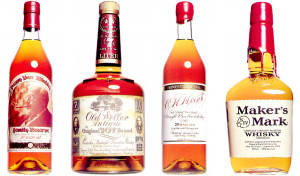The many different types of whiskey can be confusing for a beginner to understand. Whilst they all taste reasonably similar, there are subtle differences in how they are created that gives them different flavors. They can also be classified based on where they originate from i.e. a Scotch whisky, an Irish whisky or a Tennessee whiskey.
Much of the whiskey classification system is confusing and relates to regional politics. Some readers may be aware that only sparkling white wine produced in France can be called Champagne, and there are similar conventions observed in the whiskey world.
Grain vs Malt Whiskey
Let us first understand how whiskeys are made. They are made from either any type of grain (grain whiskeys) or exclusively of malted barley (malt whiskeys). Malt whiskeys are associated with Scotland and Ireland, and grain whiskeys are often associated with North America. Blended whiskeys are a combination of grain and malt whiskeys.
A single malt whiskey is a whiskey that is made from one distillery using one melted grain. It’s quite frequent that many different distilleries contribute to a whiskey, and this is called a blended malt whiskey.
Let’s now dig a little deeper in to the grains involved. Rye whisky, commonly associated with Canada, is distilled from at least 51% rye. Wheat whiskey must be distilled from a mash of at least 51% wheat. Corn whiskey must be distilled from a mash of at least 80% corn.
Bourbon must be distilled from a mash of at least 51% corn to be called bourbon. It’s therefore correct to say that all bourbons are whiskeys, but not all whiskeys are bourbons. Tennessee whiskey is a bourbon that is produced in Tennessee. It goes through an extra step of filtration through a sugar maple charcoal that provides a slightly different taste.

Other Words Used To Denote Different Types of Whiskey
A blended whiskey is a whiskey created by mixing different types of whiskeys together. The result is often milder than a straight whiskey and its lack of purity leads it to be less well regarded.
Single barrel whiskey is quite rare, as it is the whiskey of a single barrel from a single distillery. Most distilleries will use whiskeys from different barrels to create a whiskey, as each barrel will have a slightly different taste. Not combining the barrels can lead to each bottle having a slightly different taste, and distilleries combine barrels so that taste can be consistent.
Cask strength, or barrel-proof whiskies, are especially rare and very expensive. They are bottled directly from the cask without dilution.
Scotch Whisky vs Irish Whiskey
Some regions, especially Ireland and Scotland, have other processes that must be followed in order for a whiskey to be classified as an Irish whiskey or Scotch whisky. Each must be distilled in the specific country and aged for at least three years in an oak cask. Irish whiskey is often distilled using pot stills and does not have a peat flavor (peat being dried vegetation that is burned to smoke-dry barley). Scotch whisky frequently uses peat, hence its smokey flavor.
Savvy readers may have noticed the lack of E in Scotch Whisky when compared to Irish Whiskey. Americans and Scottish tend to spell it ‘whisky’, whereas Irish, Canadian and Japanese folk tend to spell it ‘whiskey’. Spelling it the wrong way can cause upset among patriotic drinkers, but there are surely more important things to be upset about in the world.
Conclusion
The most important things to understand are what makes a malt, what makes a bourbon and whether you can call something Scotch or not. The names of different types of whiskey can be confusing, but luckily, they all taste good anyway.